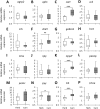Appetite regulating genes may contribute to herbivory versus carnivory trophic divergence in haplochromine cichlids
- PMID: 31998557
- PMCID: PMC6977467
- DOI: 10.7717/peerj.8375
Appetite regulating genes may contribute to herbivory versus carnivory trophic divergence in haplochromine cichlids
Abstract
Feeding is a complex behaviour comprised of satiety control, foraging, ingestion and subsequent digestion. Cichlids from the East African Great Lakes are renowned for their diverse trophic specializations, largely predicated on highly variable jaw morphologies. Thus, most research has focused on dissecting the genetic, morphological and regulatory basis of jaw and teeth development in these species. Here for the first time we explore another aspect of feeding, the regulation of appetite related genes that are expressed in the brain and control satiety in cichlid fishes. Using qPCR analysis, we first validate stably expressed reference genes in the brain of six haplochromine cichlid species at the end of larval development prior to foraging. We next evaluate the expression of 16 appetite related genes in herbivorous and carnivorous species from the parallel radiations of Lake Tanganyika, Malawi and Victoria. Interestingly, we find increased expression of two appetite-regulating genes (anorexigenic genes), cart and npy2r, in the brain of carnivorous species in all the three lakes. This supports the notion that appetite gene regulation might play a part in determining trophic niche specialization in divergent cichlid species, already prior to exposure to different diets. Our study contributes to the limited body of knowledge on the neurological circuitry that controls feeding transitions and adaptations in cichlids and other teleosts.
Keywords: Adaptive radiation; Anorexigenic; Appetite regulation; Brain; Cichlids; East African Lakes; Gene expression; Larval development; Orexigenic; Trophic specialization.
©2020 Ahi et al.
Conflict of interest statement
The authors declare there are no competing interests.
Figures



Similar articles
-
Expression variations in ectodysplasin-A gene (eda) may contribute to morphological divergence of scales in haplochromine cichlids.BMC Ecol Evol. 2022 Mar 10;22(1):28. doi: 10.1186/s12862-022-01984-0. BMC Ecol Evol. 2022. PMID: 35272610 Free PMC article.
-
Divergence in larval jaw gene expression reflects differential trophic adaptation in haplochromine cichlids prior to foraging.BMC Evol Biol. 2019 Jul 24;19(1):150. doi: 10.1186/s12862-019-1483-3. BMC Evol Biol. 2019. PMID: 31340758 Free PMC article.
-
Maternal mRNA input of growth and stress-response-related genes in cichlids in relation to egg size and trophic specialization.Evodevo. 2018 Dec 1;9:23. doi: 10.1186/s13227-018-0112-3. eCollection 2018. Evodevo. 2018. PMID: 30519389 Free PMC article.
-
East African cichlid lineages (Teleostei: Cichlidae) might be older than their ancient host lakes: new divergence estimates for the east African cichlid radiation.BMC Evol Biol. 2019 Apr 25;19(1):94. doi: 10.1186/s12862-019-1417-0. BMC Evol Biol. 2019. PMID: 31023223 Free PMC article.
-
East African cichlid fishes.Evodevo. 2023 Jan 5;14(1):1. doi: 10.1186/s13227-022-00205-5. Evodevo. 2023. PMID: 36604760 Free PMC article. Review.
Cited by
-
Expression variations in ectodysplasin-A gene (eda) may contribute to morphological divergence of scales in haplochromine cichlids.BMC Ecol Evol. 2022 Mar 10;22(1):28. doi: 10.1186/s12862-022-01984-0. BMC Ecol Evol. 2022. PMID: 35272610 Free PMC article.
-
Conserved Molecular Players Involved in Human Nose Morphogenesis Underlie Evolution of the Exaggerated Snout Phenotype in Cichlids.Genome Biol Evol. 2023 Apr 6;15(4):evad045. doi: 10.1093/gbe/evad045. Genome Biol Evol. 2023. PMID: 36930462 Free PMC article.
-
Appetite regulating genes in zebrafish gut; a gene expression study.PLoS One. 2022 Jul 19;17(7):e0255201. doi: 10.1371/journal.pone.0255201. eCollection 2022. PLoS One. 2022. PMID: 35853004 Free PMC article.
-
Molecular mechanisms underlying nuchal hump formation in dolphin cichlid, Cyrtocara moorii.Sci Rep. 2019 Dec 30;9(1):20296. doi: 10.1038/s41598-019-56771-7. Sci Rep. 2019. PMID: 31889116 Free PMC article.
-
Species specificity and sexual dimorphism in tooth shape among the three sympatric haplochromine species in Lake Kivu cichlids.Ecol Evol. 2020 May 14;10(12):5694-5711. doi: 10.1002/ece3.6309. eCollection 2020 Jun. Ecol Evol. 2020. PMID: 32607184 Free PMC article.
References
-
- Adams MA, Johnsen PB. Chemical signals in vertebrates 4. Springer US; Boston: 1986. Chemical control of feeding in herbivorous and carnivorous fish; pp. 45–61. - DOI
-
- Agulleiro MJ, Cortés R, Leal E, Ríos D, Sánchez E, Cerdá-Reverter JM. Characterization, tissue distribution and regulation by fasting of the agouti family of peptides in the sea bass (Dicentrarchus labrax) General and Comparative Endocrinology. 2014;205:251–259. doi: 10.1016/j.ygcen.2014.02.009. - DOI - PubMed
Grants and funding
LinkOut - more resources
Full Text Sources

